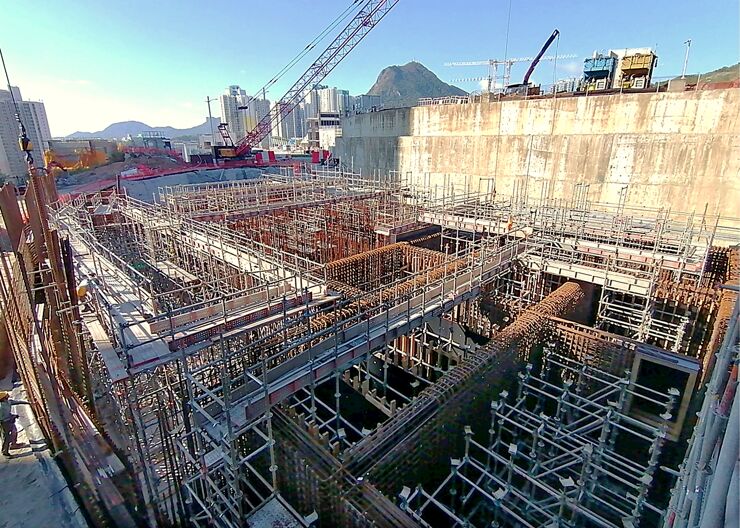
The Water Supplies Department (WSD) of the Government of the Hong Kong Special Administrative Region of the People’s Republic of China is using NEC to implement the first district-based grey-water treatment plant in Hong Kong.
Due to be operational in 2024, the plant at the 40 ha Anderson Road Quarry site in Kowloon will provide up to 3,300 m3/day of recycled grey water for toilet flushing and other non-potable uses to a new development with a planned population of about 30,000. By recycling grey water generated by the people who will eventually live there, it will avoid using freshwater for non-potable use, minimise power for pumping and reduce sewage treatment load.
WSD let the works to a joint venture of Paul Y Engineering and Tsun Yip under a HK$333 million (£35 million) NEC4 Engineering and Construction Contract (ECC) Option C (target contract with activity schedule) in September 2020. The NEC project manager is the chief engineer of WSD Consultants Management Division and Binnies Hong Kong Limited is the client’s designer and project manager’s delegate.
In addition to an underground membrane bioreactor treatment plant, the recycling system includes a pumping system, service reservoir, collection and distribution pipework, access roads and landscaping. The project was highly commended for the 2022 NEC Sustainability Award of the Year and won the 2021 Institution of Civil Engineers Chris Binnie Award for Sustainable Water Management.
Mutual trust and cooperation
WSD project manager TT Lin says, “In line with the NEC requirement to act in a ‘spirit of mutual trust and co-operation,’ all project team members have been working proactively, transparently and collaboratively to achieve successful delivery. Despite the impact of the Covid-19 pandemic, the project is still on schedule and within budget.”
He cites ongoing environment management as an example of how NEC is benefitting the project. “Following NEC’s collaborative approach, the client, project manager and contractor are continuously communicating on environmental issues such as air, noise and wastewater pollution. Together we set targets and jointly plan and execute mitigation measures. As a result, the environmental nuisance to nearby residents is minimal.”
Lin says ECC Option C’s effective payment mechanism of defined cost has also contributed to the contractor’s positive attitude to mitigating environmental impact. “Another benefit of ECC Option C is the pain-gain share mechanism, which has incentivised the contractor to propose designs for the electrical and mechanical plant that minimise construction time and reduce costs.”
He adds that the NEC early warning process has greatly enhanced problem-solving, with any issues arising on site being jointly and quickly resolved. “For example, the site abuts a proposed slope awaiting backfilling by another government department. To avoid an interface delay, the team worked collaboratively to explore alternatives, resulting in an inter-departmental agreement for the contractor to carry out the backfilling and keep the project on schedule.”
Digital collaboration
Project manager’s delegate Stephanus Shou of Binnies says NEC-inspired collaboration has extended to the adoption of ‘digital twin’ technology for smart monitoring and optimised control of the treatment process. “The project is piloting the use of digital twins in Hong Kong to simulate operational behaviour, maximise performance and reduce greenhouse gas emissions.”
He says the selection, calibration, testing, commissioning and efficient operation of the digital twin has required extensive involvement of the project team, electrical and mechanical subcontractor, digital twin specialist subcontractor and future operators. “To ensure effective collaboration among all parties, we arranged NEC partnering workshops and champion-group meetings to build up and promote mutual trust and cooperation.”
Shou says collaboration on the project is also enhanced by extensive use of building information modelling (BIM) technology. “The project team is working together on a single BIM model incorporating all project details, including electrical and mechanical works designed by the contractor. This has fostered an information-sharing culture among the team, which helps to resolve site problems promptly and minimise any impact on time and programme.”
Benefits of using NEC
- NEC encourages the client, project manager and contractor to work in a ‘spirit of mutual trust and co-operation,’ fostering a collaborative working culture.
- NEC-inspired team spirit is driving the search for alternative construction sequences to ensure more efficient project delivery.
- NEC early warning meetings significantly shorten the time taken for problem solving, enabling quick assessment and minimising any impact on programme and budget.
- NEC improves risk management to guarantee effective delivery of the project.




